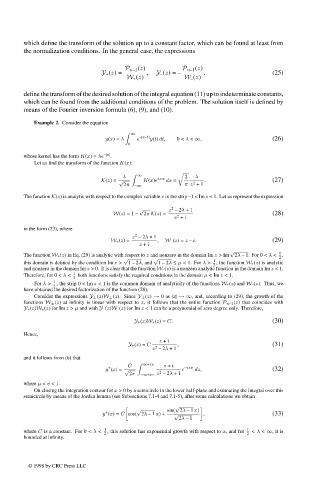Page 583 - Handbook Of Integral Equations
P. 583
which define the transform of the solution up to a constant factor, which can be found at least from
the normalization conditions. In the general case, the expressions
P n–1 (z) P n–1 (z)
Y + (z)= , Y – (z)= – , (25)
W + (z) W – (z)
define the transform of the desired solution of the integral equation (11) up to indeterminate constants,
which can be found from the additional conditions of the problem. The solution itself is defined by
means of the Fourier inversion formula (6), (9), and (10).
Example 2. Consider the equation
∞
y(x)= λ e –|x–t| y(t) dt, 0 < λ < ∞, (26)
0
whose kernel has the form K(x)= λe –|x| .
Let us find the transform of the function K(x):
λ ∞ izx 2 λ
K(z)= √ K(x)e dx = . (27)
2
2π –∞ π z +1
The function K(z) is analytic with respect to the complex variable z in the strip –1<Im z < 1. Let us represent the expression
2
√ z – 2λ +1
W(z)=1 – 2π K(z)= (28)
2
z +1
in the form (23), where
2
z – 2λ +1
W +(z)= , W –(z)= z – i. (29)
z + i
√
The function W +(z) in Eq. (29) is analytic with respect to z and nonzero in the domain Im z >Im 2λ – 1. For 0 < λ < 1 ,
√ √ 1 2
this domain is defined by the condition Im z > 1 – 2λ, and 1 – 2λ ≤ µ <1. For λ > 2 , the function W +(z) is analytic
and nonzero in the domain Im z > 0. It is clear that the function W –(z) is a nonzero analytic function in the domain Im z <1.
Therefore, for 0 < λ < 1 both functions satisfy the required conditions in the domain µ <Im z <1.
2
For λ > 1 2 , the strip 0 < Im z < 1 is the common domain of analyticity of the functions W +(z) and W –(z). Thus, we
have obtained the desired factorization of the function (28).
Consider the expressions Y ±(z)W ±(z). Since Y ±(z) → 0as |z| →∞, and, according to (29), the growth of the
functions W ±(z)atinfinity is linear with respect to z, it follows that the entire function P n–1 (z) that coincides with
Y +(z)W +(z) for Im z > µ and with Y –(z)W –(z) for Im z < 1 can be a polynomial of zero degree only. Therefore,
Y +(z)W +(z)= C. (30)
Hence,
z + i
Y +(z)= C , (31)
2
z – 2λ +1
and it follows from (6) that
∞+iv
C z + i
+ –izx
y (x)= √ e dz, (32)
2
2π –∞+iv z – 2λ +1
where µ < v <1.
On closing the integration contour for x > 0 by a semicircle in the lower half-plane and estimating the integral over this
semicircle by means of the Jordan lemma (see Subsections 7.1-4 and 7.1-5), after some calculations we obtain
√
√ sin( 2λ – 1 x)
+
y (x)= C cos( 2λ – 1 x)+ √ , (33)
2λ – 1
where C is a constant. For 0 < λ < 1 2 , this solution has exponential growth with respect to x, and for 1 2 < λ < ∞,it is
bounded at infinity.
© 1998 by CRC Press LLC
© 1998 by CRC Press LLC
Page 566

